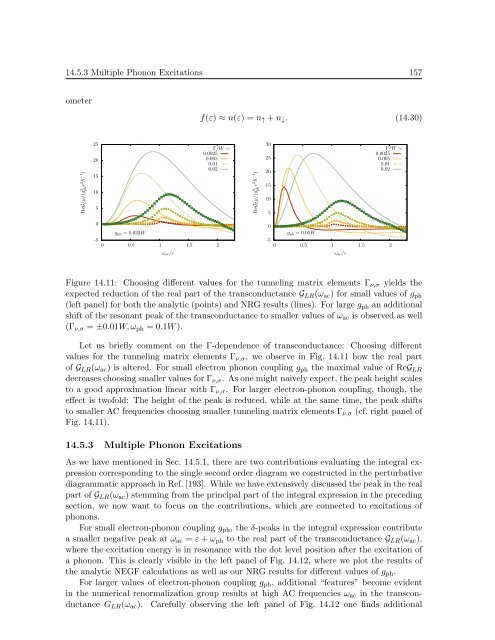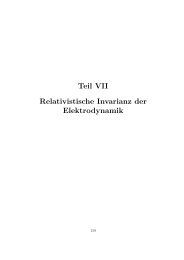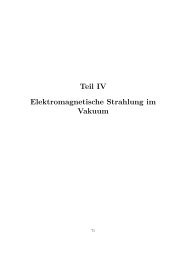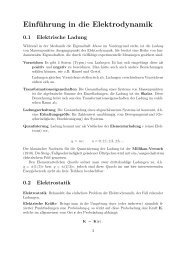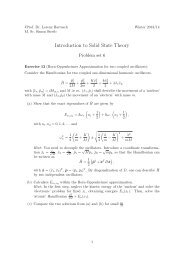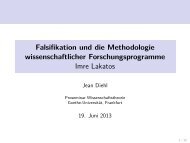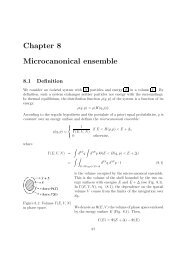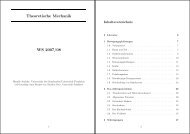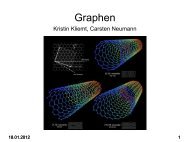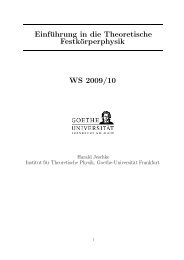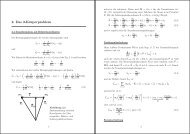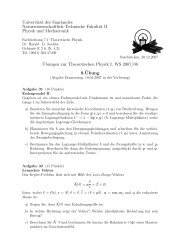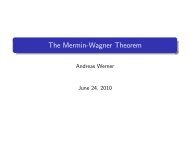A Numerical Renormalization Group Approach to Dissipative ...
A Numerical Renormalization Group Approach to Dissipative ...
A Numerical Renormalization Group Approach to Dissipative ...
Create successful ePaper yourself
Turn your PDF publications into a flip-book with our unique Google optimized e-Paper software.
14.5.3 Multiple Phonon Excitations 157<br />
ometer<br />
ReGLR/(g 2 ph e2 ¯h −1 )<br />
25<br />
20<br />
15<br />
10<br />
5<br />
0<br />
gph = 0.033W<br />
-5<br />
0 0.5 1 1.5 2<br />
ωac/ε<br />
f(ε) ≈ n(ε) = n↑ + n↓. (14.30)<br />
Γ/W =<br />
0.0025<br />
0.005<br />
0.01<br />
0.02<br />
ReGLR/(g 2 ph e2 ¯h −1 )<br />
30<br />
25<br />
20<br />
15<br />
10<br />
5<br />
0<br />
gph = 0.05W<br />
-5<br />
0 0.5 1 1.5 2<br />
ωac/ε<br />
Γ/W =<br />
0.0025<br />
0.005<br />
0.01<br />
0.02<br />
Figure 14.11: Choosing different values for the tunneling matrix elements Γν,σ yields the<br />
expected reduction of the real part of the transconductance GLR(ωac) for small values of gph<br />
(left panel) for both the analytic (points) and NRG results (lines). For large gph an additional<br />
shift of the resonant peak of the transconductance <strong>to</strong> smaller values of ωac is observed as well<br />
(Γν,σ = ±0.01W, ωph = 0.1W ).<br />
Let us briefly comment on the Γ-dependence of transconductance: Choosing different<br />
values for the tunneling matrix elements Γν,σ, we observe in Fig. 14.11 how the real part<br />
of GLR(ωac) is altered. For small electron phonon coupling gph the maximal value of ReGLR<br />
decreases choosing smaller values for Γν,σ. As one might naively expect, the peak height scales<br />
<strong>to</strong> a good approximation linear with Γν,σ. For larger electron-phonon coupling, though, the<br />
effect is twofold: The height of the peak is reduced, while at the same time, the peak shifts<br />
<strong>to</strong> smaller AC frequencies choosing smaller tunneling matrix elements Γν,σ (cf. right panel of<br />
Fig. 14.11).<br />
14.5.3 Multiple Phonon Excitations<br />
As we have mentioned in Sec. 14.5.1, there are two contributions evaluating the integral expression<br />
corresponding <strong>to</strong> the single second order diagram we constructed in the perturbative<br />
diagrammatic approach in Ref. [193]. While we have extensively discussed the peak in the real<br />
part of GLR(ωac) stemming from the principal part of the integral expression in the preceding<br />
section, we now want <strong>to</strong> focus on the contributions, which are connected <strong>to</strong> excitations of<br />
phonons.<br />
For small electron-phonon coupling gph, the δ-peaks in the integral expression contribute<br />
a smaller negative peak at ωac = ε + ωph <strong>to</strong> the real part of the transconductance GLR(ωac),<br />
where the excitation energy is in resonance with the dot level position after the excitation of<br />
a phonon. This is clearly visible in the left panel of Fig. 14.12, where we plot the results of<br />
the analytic NEGF calculations as well as our NRG results for different values of gph.<br />
For larger values of electron-phonon coupling gph, additional “features” become evident<br />
in the numerical renormalization group results at high AC frequencies ωac in the transconductance<br />
GLR(ωac). Carefully observing the left panel of Fig. 14.12 one finds additional


